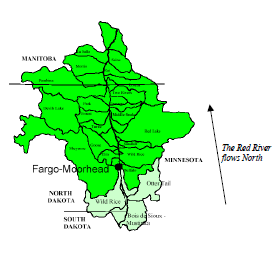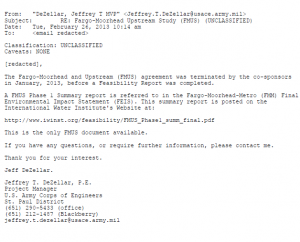A Wa$teful Flood Study
To the editor:
Here we go again.
The governing board, the Diversion Authority (DA) of the Fargo-Moorhead Metropolitan Area Flood Risk Management plan, requested the Red River Basin Commission do a study of possible flood reduction by the use of distributed retention.
The Halstead Upstream Retention-Long Term Flood Solutions (HUR-LTFS) is that study of distributed retention as a means to reduce basin wide flooding. This material has been compiled and the full presentation to the public is now postponed. The Fargo-Moorhead Diversion Authority has been “chomping at the bit” for months to see the results of the completed study. Now we have an announcement: “The HUR-LTFS Implementation Committee meeting that we have scheduled for 22 October 2013, is being postponed until a later date (yet to be determined),” says Lance Yohe.
As the study’s preliminary data shows a larger reduction in runoff due to distributed retention through the whole basin, what is the problem? Perhaps the answer they got was not the answer the Diversion Authority wanted?
This study was to evaluate the retention possibilities in the North Dakota, South Dakota and Minnesota water sheds. The ‘”water boards/water shed districts” were asked where they thought they could store water. They have completed the studies, but now Lance Yohe of the RRBC is going to have a peer review of the HUR-LTFS study results.
“The reason for this delay is so that the efforts to date can be peer reviewed by federal (USACE) and state (MN DNR and ND SWC) agencies. We need to make certain that everyone is in agreement with the effort and decisions, so that what is happening with HUR is compatible with the FM Flood Protection efforts and the MN EIS.” – (Lance Yohe)
The study is now to be analyzed to see if it is compatible with the FM Diversion? The FM Diversion is to have no distributed retention, and has no provision for any to be included in the plan. If distributed retention can be found to reduce impacts to upstream or downstream interests, or the whole basin for that matter, it does not matter. The USACE has dismissed distributed retention, wholly or in combination with other measures, as a part of an approved plan.


.
The only possible “compatibility” a study could have with the efforts and decisions (goals) of the FM Diversion is to have no distributed retention.
Here we go again. This study, with the best modeling, best data collection available and participation from all parties is shelved until when? “We still hope to have the meeting this year,” writes Lance Yohe. What we have paid for is, apparently, one more monumental waste of tax dollars and a waste of the hard work of water agencies to put the study together.
Just like the previous efforts, this study has been done with tax dollars and has fallen to the divisive politics of special interests. If and when the results are ever released, we will know what is really going on; for now this is not an open and transparent process.
Trana Rogne
Kindred, ND
Also featured in the:
Views: 124
FARGO-MOORHEAD METRO AREA FLOOD CONTROL AND RED RIVER BASIN FLOOD CONTROL ISSUES
SPECIAL HEARING MAY 27, 2009–FARGO, ND
Comments,
“The first step in minimizing future flood damage is to restrict
development–urban, rural, agricultural, industrial, and commercial–in
the areas within the flood plain. We urge the communities responsible
for making land-use decisions to act wisely in this regard, and
restrict development in areas that are known to be at high flood risk.
If communities can limit development within the flood plain, the
largest and most expensive issue related to flood risk management has
been resolved before it ever has become a problematic issue.”
Brigadier General Michael J. Walsh.
Division Commander, Mississippi Valley Division, Army Corps of Engineers.
“We recognize floods are here to stay and we need to be better at
managing the risk of even greater events in the future. We need to
build out of harms way instead of trying to control the inevitable next
flood.
Need to focus on risk management not avoiding the need for flood
insurance.”
Mark Holsten, Commissioner of the Minnesota
Department of Natural Resources.
The FM Diversion Authority has not taken this to heart and still thinks they can out maneuver old mother nature.
http://www.gpo.gov/fdsys/pkg/CHRG-111shrg55140/html/CHRG-111shrg55140.htm
Found a gem in the link Trana. in the testimony Dennis Walaker stated “Permanent protection through Fargo, including upstream retention and
overland flood protection throughout the Fargo-Moorhead area, is needed
as soon as possible”
Note the upstream part. WHAT CHANGED? Why are they now sowing FUD (Fear, Uncertainty, Doubt) from those of us who are working for that.
Ask your self why delay the Basin Wide Study? Why delay the upstream storage, when Walaker himself testified under oath that it was necessary?
Why belittle those who advocate the same with vague editorials?